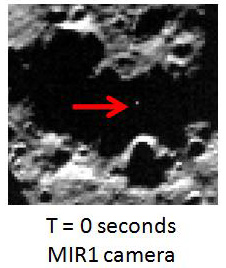When NASA slammed the 700 kg (1500 pound) 2400 kg (5200 pound) Centaur rocket booster into the Moon on October 9, the hope was that it would make a plume visible from Earth. Terrestrials were disappointed, however, when none was seen.
However, a better view was to be had by LCROSS, the Lunar Crater Sensing and Observation spacecraft, which shepherded and closely followed the rocket booster, impacting itself just minutes later. From its much closer (and doomed) location it spotted both the plume and the flash of impact! Here’s the plume:
I’ll be honest with you, it’s not much to see. For some reason, the plume was not several kilometers high as hoped, but instead more like only one or maybe two (and, it seems, blocked from our Earthly view by the rim of a crater). In the above image, taken 15 seconds after the booster impact, the plume was 6-8 kilometers wide. The fact that it was not as bright as hoped is itself interesting, however! The actual plume brightness was at the low end of what was expected, which may be due to the nature of the material it slammed into.
 There was never really a chance to see the flash from Earth, since it was at the bottom of a crater blocked from our view. But LCROSS was directly above the crater when the Centaur hit, and took several images, including the one shown here right at the moment of impact. This image shows the flash in the mid-infrared, beyond what our eyes can see but where a lot of the energy of the impact went. Other images can be found on the NASA site.
There was never really a chance to see the flash from Earth, since it was at the bottom of a crater blocked from our view. But LCROSS was directly above the crater when the Centaur hit, and took several images, including the one shown here right at the moment of impact. This image shows the flash in the mid-infrared, beyond what our eyes can see but where a lot of the energy of the impact went. Other images can be found on the NASA site.
The crater carved out by the Centaur was less than 30 meters across. That’s far too small to be seen from Earth (our limit, even with Hubble, is more than 100 meters in size), but the orbiting Lunar Reconnaissance Orbiter should be able to see it easily, and in fact did take observations of the impact just a minute or so after it happened.
All of these data are being analyzed right now. Did any of those instruments see the signature of water in the plume? Did the much larger LCROSS impact (it had a mass of 2000 kg) dig up any water? No one’s telling right now, but I suspect we’ll know soon enough. You can read more about this at Universe Today.
Update: Somehow, in my head, I got the masses of LCROSS and the Centaur reversed. Apologies, and thanks to IVAN3MAN for correcting me!